A Decadal Global Climatology of Ice Cloud Fraction with Their Microphysical and Optical Properties Inferred from the CALIPSO and Reanalysis Data
Abstract
1. Introduction
2. Data and Methods
2.1. The Cloud-Aerosol Lidar and Infrared Pathfinder Satellite Observation (CALIPSO)/CALIOP Level-3 Ice Cloud Product
2.2. Methodology
3. Results
3.1. Seasonal Zonal Altitude Distributions of Ice Cloud Fraction (ICF)
3.2. Seasonal Zonal Altitude Distributions of Ice Water Content (IWC)
3.3. Mean Profiles of Diurnal Variations of ICF and IWC
3.4. Spatial and Seasonal Occurrence Frequency of Ice Cloud Optical Depth (ICOD)
3.5. Diurnal Variations of Occurrence Frequency of ICOD
3.6. Relationships between Meteorological Variables and IWC, and ICOD
4. Discussion
5. Conclusions
Author Contributions
Funding
Acknowledgments
Conflicts of Interest
References
- Wylie, D.P.; Jackson, D.L.; Menzel, W.P.; Bates, J.J. Trends in Global Cloud Cover in Two Decades of HIRS Observations. J. Clim. 2005, 18, 3021–3031. [Google Scholar] [CrossRef]
- Mülmenstädt, J.; Sourdeval, O.; Delanoe, J.; Quaas, J. Frequency of occurrence of rain from liquid-, mixed-, and ice-phase clouds derived from A-Train satellite retrievals. Geophys. Res. Lett. 2015, 42, 6502–6509. [Google Scholar] [CrossRef]
- Hong, Y.; Liu, G.; Li, J.-L.F. Assessing the Radiative Effects of Global Ice Clouds Based on CloudSat and CALIPSO Measurements. J. Clim. 2016, 29, 7651–7674. [Google Scholar] [CrossRef]
- Lee, J.; Yang, P.; Dessler, A.; Gao, B.-C.; Platnick, S. Distribution and Radiative Forcing of Tropical Thin Cirrus Clouds. J. Atmos. Sci. 2009, 66, 3721–3731. [Google Scholar] [CrossRef]
- Baran, A.J. From the single-scattering properties of ice crystals to climate prediction: A way forward. Atmos. Res. 2012, 112, 45–69. [Google Scholar] [CrossRef]
- Khatri, P.; Iwabuchi, H.; Saito, M. Vertical Profiles of Ice Cloud Microphysical Properties and Their Impacts on Cloud Retrieval Using Thermal Infrared Measurements. J. Geophys. Res. Atmos. 2018, 123, 5301–5319. [Google Scholar] [CrossRef]
- Waliser, D.E.; Li, J.-L.F.; Woods, C.P.; Austin, R.T.; Bacmeister, J.; Chern, J.; Del Genio, A.; Jiang, J.H.; Kuang, Z.; Meng, H.; et al. Cloud ice: A climate model challenge with signs and expectations of progress. J. Geophys. Res. Space Phys. 2009, 114, 21. [Google Scholar] [CrossRef]
- Cesana, G.; Chepfer, H. Evaluation of the cloud thermodynamic phase in a climate model using CALIPSO-GOCCP. J. Geophys. Res. Atmos. 2013, 118, 7922–7937. [Google Scholar] [CrossRef]
- Cesana, G.; Waliser, D.E.; Jiang, X.; Li, J.F. Multimodel evaluation of cloud phase transition using satellite and reanalysis data. J. Geophys. Res. Atmos. 2015, 120, 7871–7892. [Google Scholar] [CrossRef]
- Tan, I.; Storelvmo, T.; Choi, Y.-S. Spaceborne lidar observations of the ice-nucleating potential of dust, polluted dust, and smoke aerosols in mixed-phase clouds. J. Geophys. Res. Atmos. 2014, 119, 6653–6665. [Google Scholar] [CrossRef]
- Eliasson, S.; Buehler, S.A.; Milz, M.; Eriksson, P.; John, V.O. Assessing observed and modelled spatial distributions of ice water path using satellite data. Atmos. Chem. Phys. Discuss. 2011, 11, 375–391. [Google Scholar] [CrossRef]
- Hong, Y.; Liu, G. The Characteristics of Ice Cloud Properties Derived from CloudSat and CALIPSO Measurements. J. Clim. 2015, 28, 3880–3901. [Google Scholar] [CrossRef]
- King, M.D.; Platnick, S.; Menzel, W.P.; Ackerman, S.A.; Hubanks, P.A. Spatial and Temporal Distribution of Clouds Observed by MODIS Onboard the Terra and Aqua Satellites. IEEE Trans. Geosci. Remote. Sens. 2013, 51, 3826–3852. [Google Scholar] [CrossRef]
- Holz, R.; Ackerman, S.A.; Nagle, F.W.; Frey, R.; Dutcher, S.; Kuehn, R.E.; Vaughan, M.A.; Baum, B. Global Moderate Resolution Imaging Spectroradiometer (MODIS) cloud detection and height evaluation using CALIOP. J. Geophys. Res. Space Phys. 2008, 113. [Google Scholar] [CrossRef]
- Sun, W.; Videen, G.; Kato, S.; Lin, B.; Lukashin, C.; Hu, Y. A study of subvisual clouds and their radiation effect with a synergy of CERES, MODIS, CALIPSO, and AIRS data. J. Geophys. Res. Atmos. 2011, 116, D22207. [Google Scholar] [CrossRef]
- Berry, E.; Mace, G.G.; Gettelman, A. Using A-Train Observations to Evaluate Cloud Occurrence and Radiative Effects in the Community Atmosphere Model during the Southeast Asia Summer Monsoon. J. Clim. 2019, 32, 4145–4165. [Google Scholar] [CrossRef]
- Lauer, A.; Hamilton, K. Simulating Clouds with Global Climate Models: A Comparison of CMIP5 Results with CMIP3 and Satellite Data. J. Clim. 2013, 26, 3823–3845. [Google Scholar] [CrossRef]
- Berry, E.; Mace, G.G. Cloud properties and radiative effects of the Asian summer monsoon derived from A-Train data. J. Geophys. Res. Atmos. 2014, 119, 9492–9508. [Google Scholar] [CrossRef]
- Tsushima, Y.; Ringer, M.A.; Webb, M.J.; Williams, K.D. Quantitative evaluation of the seasonal variations in climate model cloud regimes. Clim. Dyn. 2012, 41, 2679–2696. [Google Scholar] [CrossRef]
- Liu, Z.; Vaughan, M.A.; Winker, D.; Kittaka, C.; Getzewich, B.; Kuehn, R.; Omar, A.; Powell, K.; Trepte, C.; Hostetler, C. The CALIPSO Lidar Cloud and Aerosol Discrimination: Version 2 Algorithm and Initial Assessment of Performance. J. Atmos. Ocean. Technol. 2009, 26, 1198–1213. [Google Scholar] [CrossRef]
- Huang, L.; Jiang, J.; Wang, Z.; Su, H.; Deng, M.; Massie, S. Climatology of cloud water content associated with different cloud types observed by A-Train satellites. J. Geophys. Res. Atmos. 2015, 120, 4196–4212. [Google Scholar] [CrossRef]
- Su, H.; Jiang, J.H.; Vane, D.G.; Stephens, G.L. Observed vertical structure of tropical oceanic clouds sorted in large-scale regimes. Geophys. Res. Lett. 2008, 35. [Google Scholar] [CrossRef]
- Andersson, S.M.; Martinsson, B.G.; Vernier, J.-P.; Friberg, J.; Brenninkmeijer, C.A.M.; Hermann, M.; Van Velthoven, P.F.J.; Zahn, A. Significant radiative impact of volcanic aerosol in the lowermost stratosphere. Nat. Commun. 2015, 6, 7692. [Google Scholar] [CrossRef]
- Zhao, B.; Gu, Y.; Liou, K.-N.; Wang, Y.; Liu, X.; Huang, L.; Jiang, J.; Su, H. Type-Dependent Responses of Ice Cloud Properties to Aerosols From Satellite Retrievals. Geophys. Res. Lett. 2018, 45, 3297–3306. [Google Scholar] [CrossRef] [PubMed]
- Pan, H.; Bu, L.; Kumar, K.R.; Gao, H.; Huang, X.; Zhang, W. A new retrieval method for the ice water content of cirrus using data from the CloudSat and CALIPSO. J. Atmos. Solar-Terrestrial Phys. 2017, 161, 134–142. [Google Scholar] [CrossRef]
- Huang, L.; Jiang, J.; Tackett, J.L.; Su, H.; Fu, R. Seasonal and diurnal variations of aerosol extinction profile and type distribution from CALIPSO 5-year observations. J. Geophys. Res. Atmos. 2013, 118, 4572–4596. [Google Scholar] [CrossRef]
- Sassen, K.; Wang, Z. Classifying clouds around the globe with the CloudSat radar: 1-year of results. Geophys. Res. Lett. 2008, 35. [Google Scholar] [CrossRef]
- Sassen, K.; Wang, Z.; Liu, D. Global distribution of cirrus clouds from CloudSat/Cloud-Aerosol Lidar and Infrared Pathfinder Satellite Observations (CALIPSO) measurements. J. Geophys. Res. Space Phys. 2008, 113. [Google Scholar] [CrossRef]
- Lee, L.; Zhang, J.; Reid, J.S.; Yorks, J.E. Investigation of CATS aerosol products and application toward global diurnal variation of aerosols. Atmos. Chem. Phys. Discuss. 2019, 19, 12687–12707. [Google Scholar] [CrossRef]
- Sassen, K.; Cho, B.S. Subvisual-Thin Cirrus Lidar Dataset for Satellite Verification and Climatological Research. J. Appl. Meteorol. 1992, 31, 1275–1285. [Google Scholar] [CrossRef]
- Martins, E.; Noel, V.; Chepfer, H. Properties of cirrus and subvisible cirrus from nighttime Cloud-Aerosol Lidar with Orthogonal Polarization (CALIOP), related to atmospheric dynamics and water vapor. J. Geophys. Res. Space Phys. 2011, 116. [Google Scholar] [CrossRef]
- Winker, D.M.; Hunt, W.H.; McGill, M.J. Initial performance assessment of CALIOP. Geophys. Res. Lett. 2007, 34, L19803. [Google Scholar] [CrossRef]
- Winker, D.M.; Vaughan, M.A.; Omar, A.; Hu, Y.; Powell, K.A.; Liu, Z.; Hunt, W.H.; Young, S.A. Overview of the CALIPSO Mission and CALIOP Data Processing Algorithms. J. Atmos. Ocean. Technol. 2009, 26, 2310–2323. [Google Scholar] [CrossRef]
- Powell, K.A.; Hostetler, C.A.; Vaughan, M.A.; Lee, K.-P.; Trepte, C.R.; Rogers, R.R.; Winker, D.M.; Liu, Z.; Kuehn, R.E.; Hunt, W.H.; et al. CALIPSO Lidar Calibration Algorithms. Part I: Nighttime 532-nm Parallel Channel and 532-nm Perpendicular Channel. J. Atmos. Ocean. Technol. 2009, 26, 2015–2033. [Google Scholar] [CrossRef]
- Balmes, K.A.; Fu, Q.; Thorsen, T.J. Differences in Ice Cloud Optical Depth From CALIPSO and Ground-Based Raman Lidar at the ARM SGP and TWP Sites. J. Geophys. Res. Atmos. 2019, 124, 1755–1778. [Google Scholar] [CrossRef]
- Mace, G.G.; Zhang, Q.; Vaughan, M.; Marchand, R.; Stephens, G.; Trepte, C.; Winker, D. A description of hydrometeor layer occurrence statistics derived from the first year of merged Cloudsat and CALIPSO data. J. Geophys. Res. Space Phys. 2009, 114. [Google Scholar] [CrossRef]
- Villanueva, D.; Heinold, B.; Seifert, P.; Deneke, H.; Radenz, M.; Tegen, I. The day-to-day co-variability between mineral dust and cloud glaciation: A proxy for heterogeneous freezing. Atmos. Chem. Phys. Discuss. 2020, 20, 2177–2199. [Google Scholar] [CrossRef]
- Sourdeval, O.; Gryspeerdt, E.; Kraemer, M.; Goren, T.; Delanoë, J.; Afchine, A.; Hemmer, F.; Quaas, J. Ice crystal number concentration estimates from lidar–radar satellite remote sensing—Part 1: Method and evaluation. Atmos. Chem. Phys. Discuss. 2018, 18, 14327–14350. [Google Scholar] [CrossRef]
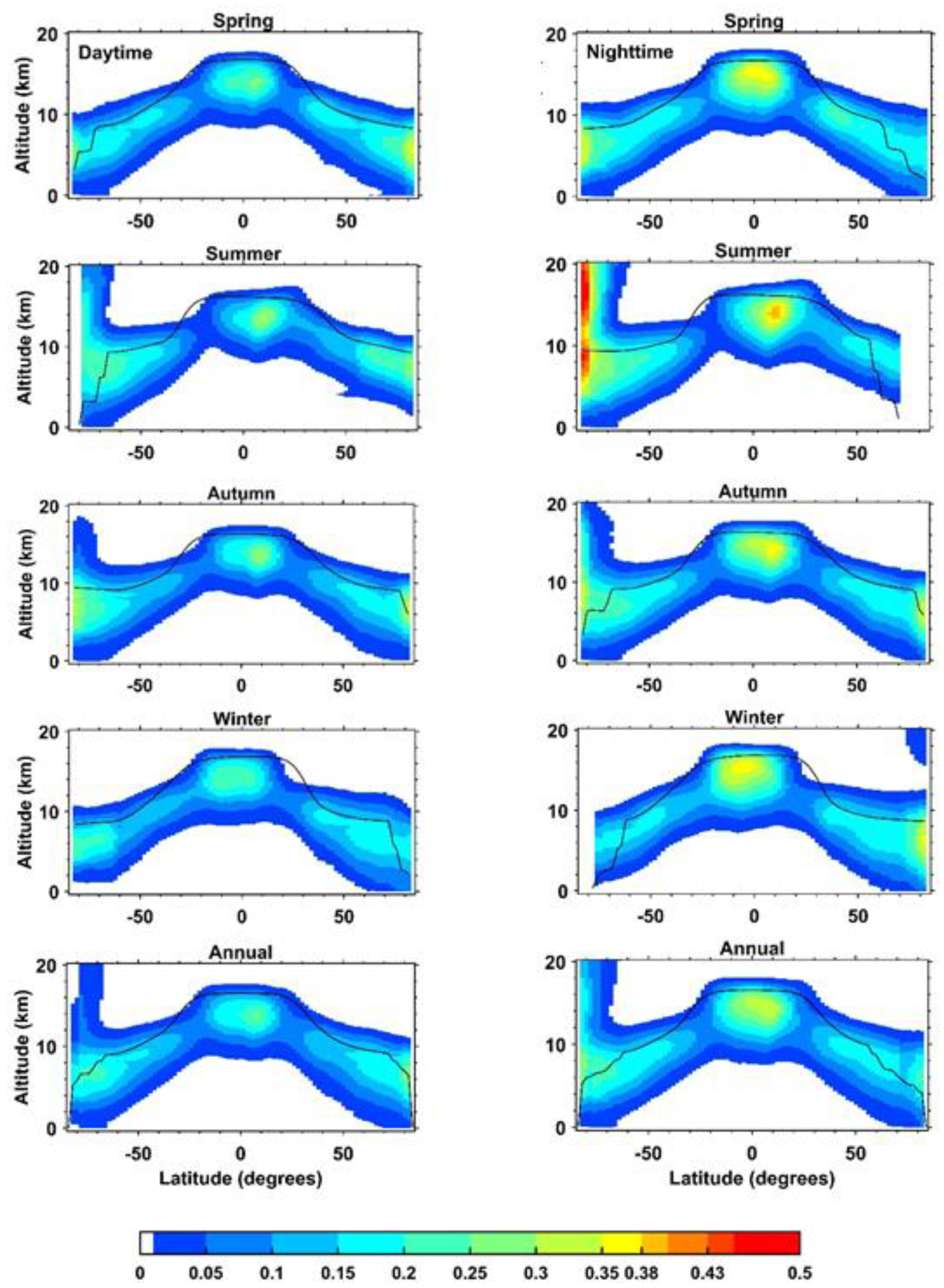

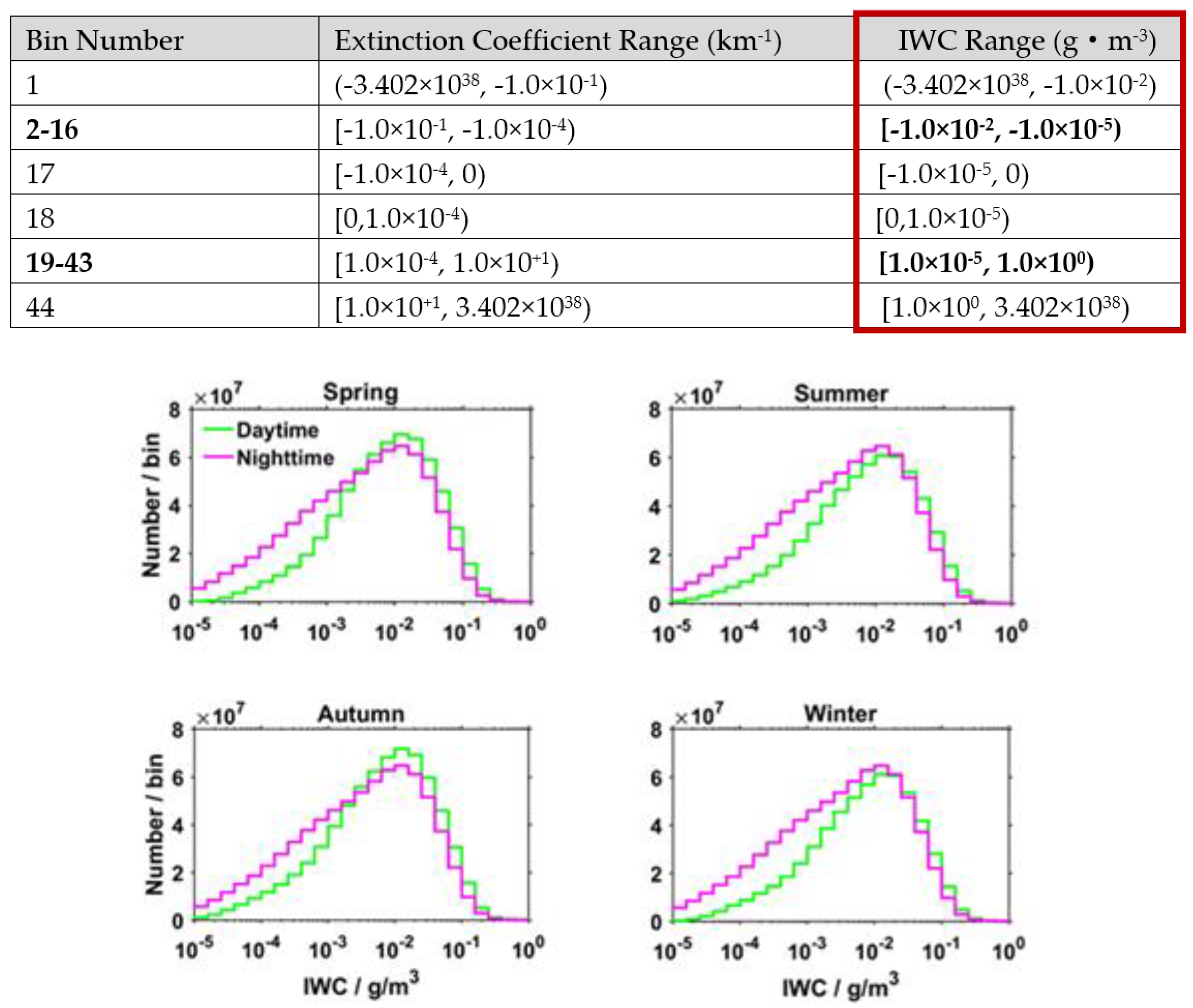
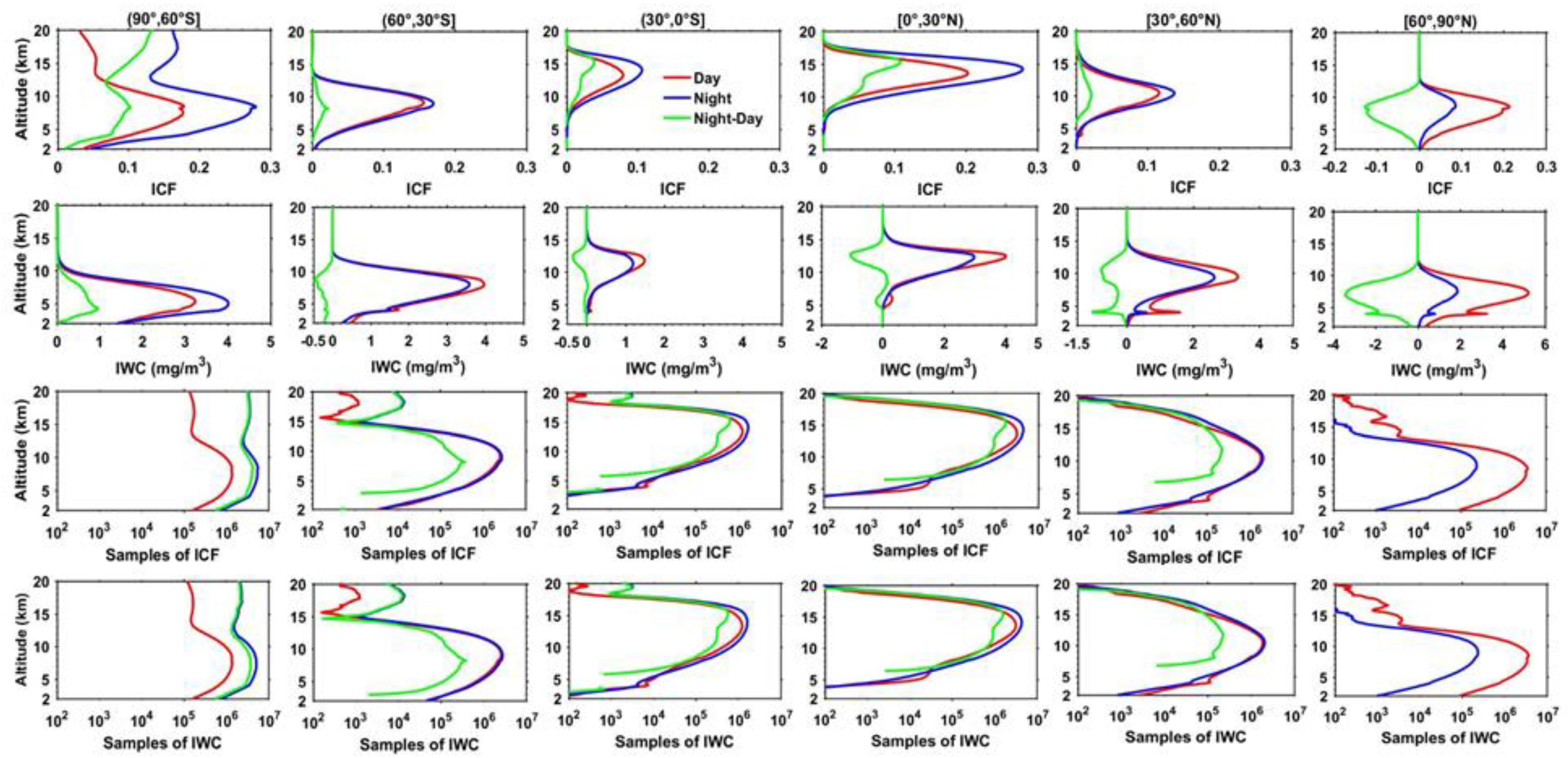

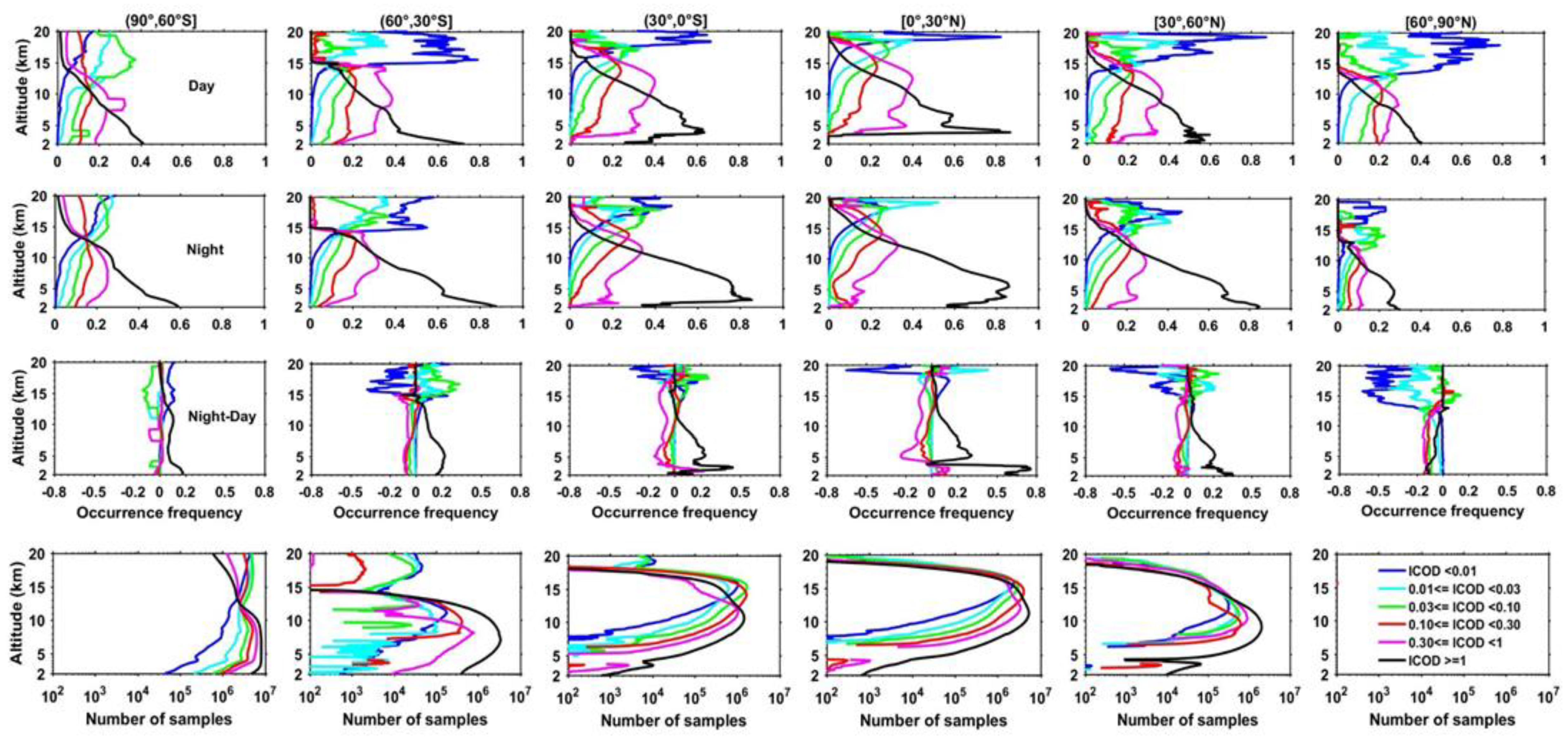

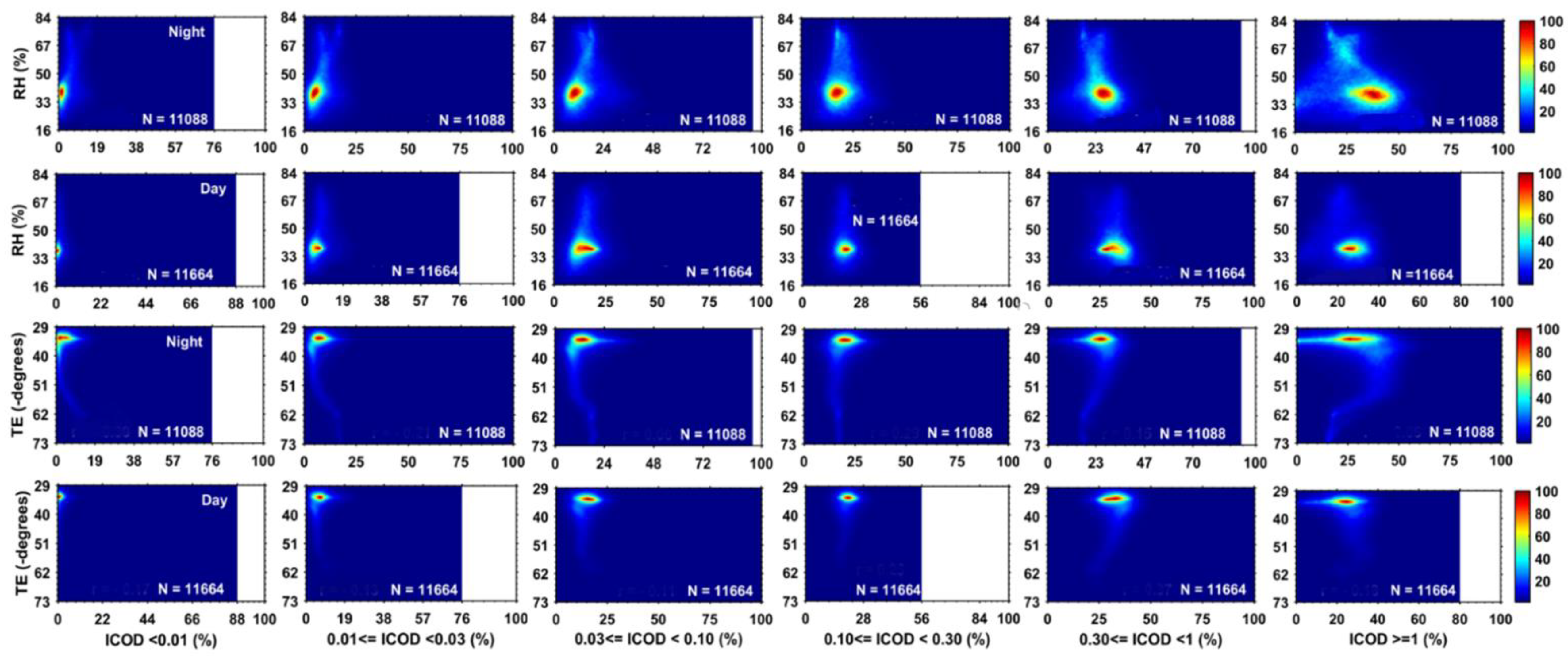
| Season | Daytime Nighttime | |||||
|---|---|---|---|---|---|---|
| Minimum | Maximum | Mean | Minimum | Maximum | Mean | |
| Spring | <0.01 | 0.35 | 0.06 | <0.01 | 0.37 | 0.07 |
| Summer | <0.01 | 0.31 | 0.05 | <0.01 | 0.48 | 0.08 |
| Autumn | <0.01 | 0.32 | 0.05 | <0.01 | 0.38 | 0.07 |
| Winter | <0.01 | 0.25 | 0.05 | <0.01 | 0.37 | 0.07 |
| Annual | <0.01 | 0.31 | 0.05 | <0.01 | 0.40 | 0.07 |
| Season | Daytime Nighttime | |||||
|---|---|---|---|---|---|---|
| Minimum | Maximum | Mean | Minimum | Maximum | Mean | |
| Spring | <0.00001 | 0.00660 | 0.00120 | <0.00001 | 0.00890 | 0.00096 |
| Summer | <0.00001 | 0.00740 | 0.00110 | <0.00001 | 0.01530 | 0.00087 |
| Autumn | <0.00001 | 0.01300 | 0.00110 | <0.00001 | 0.01230 | 0.00095 |
| Winter | <0.00001 | 0.00550 | 0.00110 | <0.00001 | 0.00560 | 0.00099 |
| Annual | <0.00001 | 0.00810 | 0.00110 | <0.00001 | 0.01050 | 0.00094 |
Publisher’s Note: MDPI stays neutral with regard to jurisdictional claims in published maps and institutional affiliations. |
© 2020 by the authors. Licensee MDPI, Basel, Switzerland. This article is an open access article distributed under the terms and conditions of the Creative Commons Attribution (CC BY) license (http://creativecommons.org/licenses/by/4.0/).
Share and Cite
Pan, H.; Wang, M.; Kumar, K.R.; Zhang, J.; Meng, L. A Decadal Global Climatology of Ice Cloud Fraction with Their Microphysical and Optical Properties Inferred from the CALIPSO and Reanalysis Data. Remote Sens. 2020, 12, 3795. https://doi.org/10.3390/rs12223795
Pan H, Wang M, Kumar KR, Zhang J, Meng L. A Decadal Global Climatology of Ice Cloud Fraction with Their Microphysical and Optical Properties Inferred from the CALIPSO and Reanalysis Data. Remote Sensing. 2020; 12(22):3795. https://doi.org/10.3390/rs12223795
Chicago/Turabian StylePan, Honglin, Minzhong Wang, Kanike Raghavendra Kumar, Jiantao Zhang, and Lu Meng. 2020. "A Decadal Global Climatology of Ice Cloud Fraction with Their Microphysical and Optical Properties Inferred from the CALIPSO and Reanalysis Data" Remote Sensing 12, no. 22: 3795. https://doi.org/10.3390/rs12223795
APA StylePan, H., Wang, M., Kumar, K. R., Zhang, J., & Meng, L. (2020). A Decadal Global Climatology of Ice Cloud Fraction with Their Microphysical and Optical Properties Inferred from the CALIPSO and Reanalysis Data. Remote Sensing, 12(22), 3795. https://doi.org/10.3390/rs12223795






